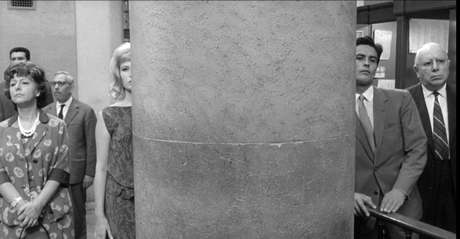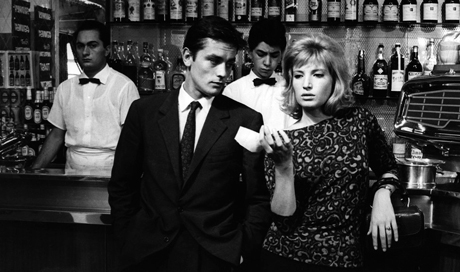Reviewed by Glenn Erickson
Art film directors were the cultural darlings of the 160s, and of the ones that became internationally known, Italian Michelangelo Antonioni tended to be discussed in the most abstract terms, as the "inventor" of cinematic alienation and ennui. Antonioni found new ways to communicate his semi-abstract meditations on modern existence, while some of the other big names were repeating themselves or retreating into nostalgia. Antonioni's visually oriented pictures don't usually require viewers' guides just to understand their surfaces. For all the talk about open-ended plots and patience-straining silences, L'avventura is a surprisingly entertaining mystery, and his La Notte is a wholly accessible story of a strained marriage
L'eclisse looks at more Italians with conflicted personal lives, but the director takes his radical narrative ideas several steps further. He does without even the pretense of a suspense story to provide easy entry for the average genre-oriented audience. In L'eclisse the camera simply observes a series of events in a young woman's life that show her responses -- or more accurately, her difficulty in finding responses -- to what seems a random and soul-less existence. The film concludes with a seven-minute visual investigation of a commonplace scene that will send anti-art people running for the exits. Stanley Kubrick must have seen L'eclisse when he dreamed up his finish for 2001: A Space Odyssey: this picture concludes in a puzzlingly ethereal auteurist mind-trip.
Young Roman single Vittoria (Monica Vitti) breaks up with Riccardo (Francisco Rabal) and finds only passing amusement with her friends. She visits her mother (Lilla Brignone), a frequent habitué of the stock exchange and meets her broker Piero (Alain Delon). Piero and Vittoria begin an association that has some amusing highlights. Vittoria studies people but has difficulty finding strong emotions, and a meaningful relationship fails to emerge.

It's important to stress how well L'eclisse is put together. This is no empty exercise but a precise construct of visuals and performances. Even when the leading character Vittoria is just marking time in her apartment or drifting from one scene to another hoping for something to shake her senses, a keen visual imagination is forever finding new ways to look at a scene. Space is used architecturally, and by that I don't just mean that compositions are well organized. The physical relationship between characters and their environment seems intuitive, never imposed. We're conditioned to seek out standardized visual signposts and signifiers in films; in this supposedly 'artsy' movie Antonioni doesn't take anything for granted. Events and objects are exactly what they are. His choice of what to show when and how gives us a trail to follow, and even without the barest outline of a plot or even a hint that the movie is going any place in particular, we're hooked.
We want to watch because Antonioni and Tonino Guerra's virtually invisible script presents a theme without hammering it home. Vittoria and her first lover Riccardo have run dry of emotion or caring. She leaves him, walking off into the strange undeveloped neighborhood where they live. He follows out of habit, not asking her back, but not rejecting her. Nothing is important enough to really go out on a limb for. Fairly secure and affluent, they nevertheless lack vitality and motivation in their lives.
At her first visit to the stock exchange Vittoria gives up connecting with her mother. She instead watches the action at the hub of materialism, as the happy brokers take advantage of an upswing in the market. She's unmoved. She visits with some friends. Inspired by some pictures in a book, she plays the role of an African princess. Her friend, whose husband works in Africa, dampens her enthusiasm by comparing the African natives to monkeys and children.

Later on Vittoria flies in an airplane. The vistas of clouds and sky momentarily exhilarate her. She returns to the stock market, which is having a bad day. The investors blame anything they can for the drop in prices. Vittoria's mother takes a heavy loss, which she has decided is the fault of a socialist conspiracy. Her broker Piero eventually hits on Vittoria and they begin a casual flirtation. Except for a few exceptional moments, Vittoria and Piero's affair has sensation but lacks deeper passions. When they walk together they seem like zombies. He still looks at other women and her attention wanders to other men. Their hands intertwine and play games but only their bodies seem to really get along.
This is made explicit when a drunk steals Piero's convertible and crashes it into a canal. The authorities haul the car out, revealing the memorable image of the corpse's hand dangling over the car's door. It reminds us of when Vittoria and Piero's casual hands dangled over the furniture when they were courting. Piero has no emotional reaction to the loss of the man or the car - he'll just repair it and sell it.
(spoiler)
For his conclusion Antonioni pulls a narrative trick that still sends film theorists into deep-dish analytical mode. Without so much as a by-your-leave, we just drop our two main characters and return to a neutral street corner where Paulo and Vittoria once spent some time. Construction of a building has apparently been halted mid-way, with the structure swathed in tarps. A rain barrel leaks water into the street. People pass by that we've seen on the periphery of previous scenes. The absence of the main characters is not missed by anything in the environment, which goes on 'existing' without them. The screen fractures into a series of visual details, pieces of architecture and bric-a-brac glimpsed as if we were standing on the corner and searching for meaning in the randomness of it all. Night falls. The film ends.

The ending does several interesting things. It betrays the commercial agreement between filmmaker and audience, for Antonioni is trying to communicate on film what no other medium can portray -- his vision of the state of existence. His characters exist to pursue consumer comforts, and only Vittoria displays even a pretense of a need for more. The man-made material doesn't seem to really need us any more, at least not as individuals. Nowhere in the film is there a sense of connectedness, purpose or emotional commitment. Yet the film itself is not a cold statement. 1
In Red Desert Antonioni complicates his worldview with both stylized color and an even more mentally disordered heroine (Vitti again). He subsequently returned to quasi-detective fiction for the far more accessible Blow-Up, the movie that flattered ordinary film fans by allowing them to appreciate art along with the espresso set. Then Zabriskie Point came along to expose Antonioni's Achilles heel -- even he could be pretentious and painfully obvious. The film fell into the hands of MGM's schlock marketers: "Zabriskie Point! How You Get There ... Depends on Where You're At!" (Exhale on a count of three.) The calm visual grace of L'eclisse remains the pure effort of a cinema artist at the height of his creativity.
The Criterion Collection's Dual-Format Blu-ray + DVD of L'eclisse is an excellent HD encoding of this B&W show. The monaural audio is bright and clear, right from the catchy Italo twist vocal that opens the film.
Disc producer Kim Hendrickson reassembles the impressive extras collected for Criterion's 2005 DVD. The leading piece is The Eye that Changed Cinema, a career docu on Antonioni for Italian television made entirely of behind-the-scenes footage and press opportunities, awards ceremonies, etc. His famous quote while presenting L'avventura about Eros in the modern world is not here, but there is plenty of quality coverage between innocuous bits of film from Death Valley, etc. A second new interview docu Elements of Landscape carefully dissects L'eclisse as do the essays by Gilberto Perez and Jonathan Rosenbaum in the disc's accompanying fat pamphlet.
The essays and visual analysis are astute but cannot touch the experience of watching L'eclisse with an open mind... it isn't particularly helpful to discover that Antonioni filmed a real solar eclipse but then did not use it and kept the title anyway. He also once planned two movies following the Vittoria and Piero characters separately, a concept that his producer wouldn't buy. The director imparts a spiritual mystery to his carefully chosen mundane images, which is difficult to capture through critical analysis.
The main documentary suggests that Antonioni's work was too individual to launch trends or inspire stylistic imitators. Most of the art film directors of the '60s can be imitated or even lampooned, but the best of Antonioni does not lend itself to copycats. Even Woody Allen's parody in a segment of his Everything You Always Wanted to Know About Sex, But Were Afraid to Ask doesn't seem to have a handle on what the Italian director's style really consists of.
On a scale of Excellent, Good, Fair, and Poor,
L'eclisse Blu-ray + DVD
rates:
Movie: Excellent
Video: Excellent
Sound: Excellent
Supplements: Audio commentary by film scholar Richard Pena; Michelangelo Antonioni: The Eye That Changed Cinema, a 56-minute docu; The Sickness of Eros, a new video piece; essays by film critics Jonathan Rosenbaum and Gilberto Perez
Deaf and Hearing-impaired Friendly?
YES; Subtitles: English
Packaging: Keep case
Reviewed: June 26, 2014
Footnotes:
1. The spacey building with what looks like a flying saucer on top (last image above) was also seen in the U.S.-Italian production The Last Man on Earth. The director of that movie clearly chose it just because it looked futuristic. Antonioni seems to stress the building's architectural hostility toward human beings -- there's nothing inviting about it whatsoever.
Return

Text © Copyright 2014 Glenn Erickson
See more exclusive reviews on the Savant Main Page.
The version of this review on the Savant main site has additional images, footnotes and credits information, and may be updated and annotated with reader input and graphics.
Return to Top of Page
|

